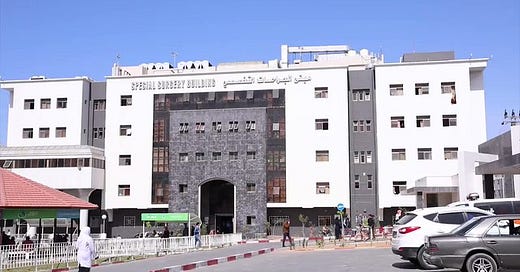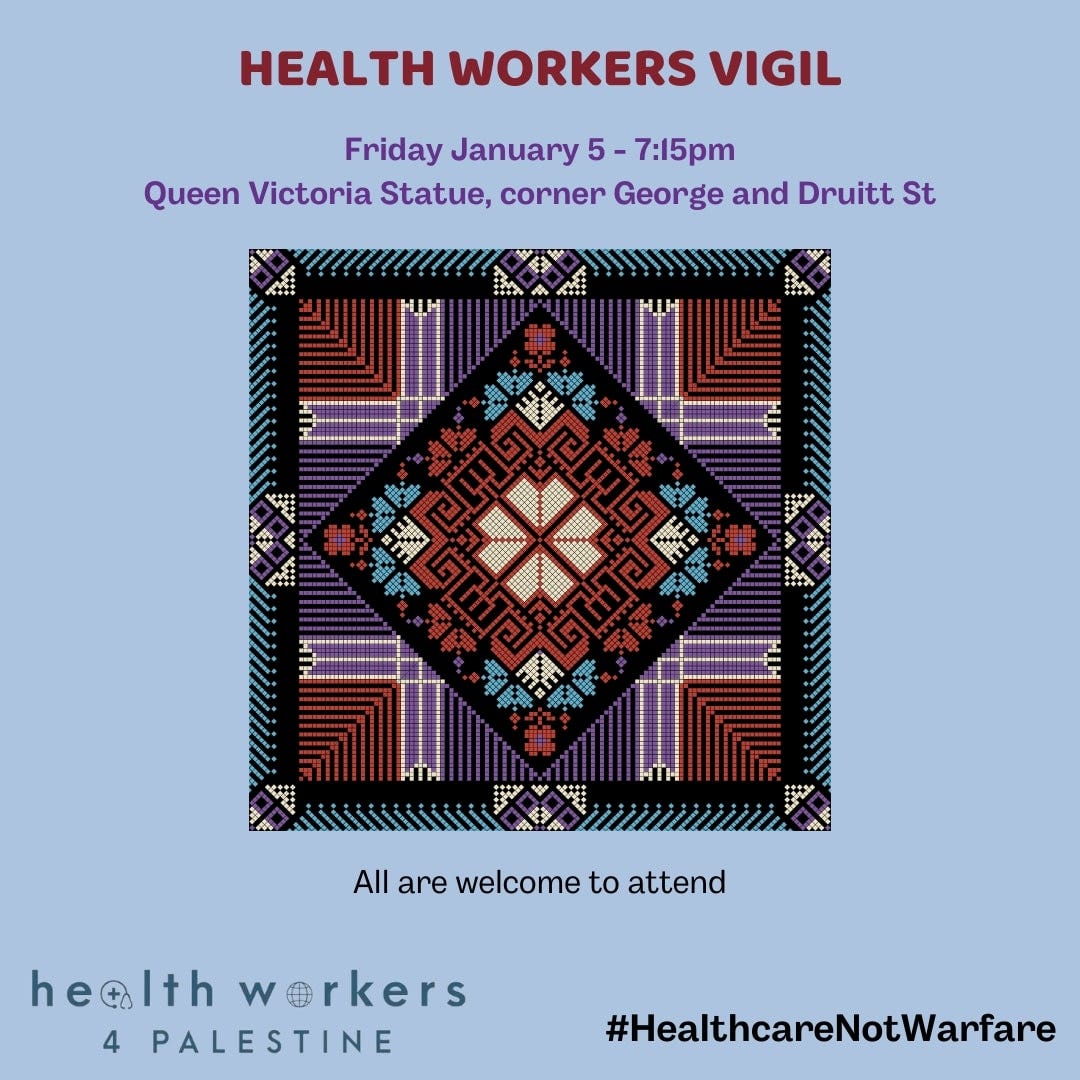The House of Healing
The international community proclaims that hospitals are not a target; in Gaza they have been targets for decades.
gauze, n., a very fine fabric of silk, cotton etc.
[derived from] Gaza, a town in Palestine, famous for the very fine transparent tissues fabricated there.
Dr. Ernest Klein, “A Comprehensive Etymological Dictionary of the English Language”
On November 20, an article was published that included an account of a ruthless attack on Al-Shifa Hospital by Israeli forces. Patients were deliberately targeted in an attempt at securing a ‘cheap victory’, and the hospital was bombarded with heavy artillery for several hours. Dozens of civilians were killed, far more wounded.
This account was sadly unremarkable in its details - many similar accounts had emerged of Israel’s indiscriminate assaults on Gaza’s healthcare infrastructure; countless civilian deaths, deliberate targeting of health workers and patients, absurd claims of hidden fortifications and threadbare justifications for collective punishment inflicted on Palestinians.
What made this particular account remarkable was the fact that it had been written in 1967, documenting an attack that had occurred on April 5 1956.
Al-Shifa hospital was originally established by the British mandatory government from a converted army barracks, under the name Dar al-Shifa, “house of healing”, and used as a quarantine. When Egypt began to administer Gaza post-1948, Al-Shifa was developed into the central hospital; a department for internal medicine was added, along with a surgery wing, later followed by buildings for paediatrics and ophthalmology.
On April 5 1956, Israeli gunners shelled Gaza city under the pretense of attacking ‘fortified encampments’ that were maintained by the Egyptian military; despite this claim, the nearest military objective was more than one kilometre away, and the shelling was centred on the city’s main street, targeting the market and Al-Shifa hospital.
Ten days later, David Ben Gurion gave a public address commemorating the 8th anniversary of Israel’s founding. In the wake of a UN-brokered ceasefire, Israel’s first Prime Minister declared that his people “shall not fear the murderous gangs dispatched by the Egyptian dictator, nor will the hosts of Amalek, from the South, the East and the North, who are now concentrating on the other side of our borders, be able to subdue us.”
The current Israeli Prime Minister, Benjamin Netanyahu, has been criticised for his own use of similar rhetoric in justifying his own attacks on Gaza. By invoking the name of Amalek, an ancient biblical nation that persecuted the original Israelites, Netanyahu has framed his carpet bombing of innocent civilians as a divinely mandated genocide. A similar comparison between Palestine and Amalek was also drawn by the American extremist Baruch Goldstein, who ruthlessly slaughtered 29 Muslims praying at a Hebron mosque in 1994. It is notable, then, that the invocation of Amalek by the leaders of modern Israel dates back at least as far as its foundation.
On December 27 2008, Israel commenced a 22-day bombardment of Gaza; the so-called Operation Cast Lead offensive killed 1,400 Palestinians and injured thousands more. The Operation was supposedly a retaliation against Hamas breaking a months-long ceasefire by firing rockets into southern Israel, although the rocket fire in question had resulted in zero deaths or injuries, and was itself a retaliation against Israeli troops invading Gaza and killing six Hamas members.
The Irish activist Caoimhe Butterfly, who was in Gaza during the attack, wrote the following in an article dated January 16, 2009:
The morgues of Gaza's hospitals are overflowing. The bodies in their blood-soaked white shrouds cover the entire floor space of the Shifa hospital morgue. Some are intact, most horribly deformed, limbs twisted into unnatural positions, chest cavities exposed, heads blown off, skulls crushed in. Family members wait outside to identify and claim a brother, husband, father, mother, wife, child. Many of those who wait their turn have lost numerous family members and loved ones.
Blood is everywhere. Hospital orderlies hose down the floors of operating rooms, bloodied bandages lie discarded in corners, and the injured continue to pour in: bodies lacerated by shrapnel, burns, bullet wounds. Medical workers, exhausted and under siege, work day and night and each life saved is seen as a victory over the predominance of death.
On July 8 2014, Israel again launched a military campaign in Gaza, Operation Protective Edge, killing 1,814 Palestinians - 86 per cent of them civilians. Over the course of this campaign, Amnesty International reported on mounting evidence that Israel was deliberately targeting health workers, according to testimonies by doctors, nurses, and ambulance personnel. As of August 5, at least 19 health workers had been killed and at least 49 injured in the course of their duties, and at least 5 hospitals had been forced to shut down.
Over the course of Operation Protective Edge, Israel maintained that Hamas operatives were using Al-Shifa Hospital as a centre of operations, despite a lack of evidence to support these claims. These claims were also rebuffed by Dr Mads Gilbert, a Norwegian anaesthetist and trauma expert who was stationed at Al-Shifa hospital at the time.
Al-Shifa continues to be a useful scapegoat and target for Israel’s assault on Gaza’s health system . On November 3 last year, an Israeli airstrike on an ambulance convoy killed 15 and injured 60; the convoy was transporting wounded patients to the Rafah border crossing. The Israeli Occupying Forces acknowledged the attack, and claimed that it had successfully targeted Hamas militants; both Human Rights Watch and The Washington Post reported that they had found no evidence to suggest that the ambulance convoy had been used for military purposes, or that any military equipment or personnel were present. Among the casualties were women and children.
Even after Al-Shifa itself was besieged and left barely functioning, Israel continued to maintain that the hospital had served as a base of operations for Hamas; a sad repeat of their decades-earlier claims of Egyptian military presence in the hospital’s vicinity. Israel also repeated their earlier breach of a ceasefire - or in this case, a “humanitarian pause”. On November 29, Israeli troops fired on a group of Palestinians in Northern Gaza, killing two. That same day, authorities had discovered the decomposing bodies of five premature babies in An-Nasr Paediatric Hospital. The facility had been forcibly evacuated by the IOF more than two weeks earlier.
All the while, Israel’s scramble for evidence that could justify the decimation of more than 20 hospitals in the Strip became more desperate. Perhaps the most egregious example was a video posted on the IOF’s official Twitter page, which showed spokesperson Daniel Hagari pointing to a piece of paper which he claimed to be a list of names of Hamas members. It was in fact a calendar, and the supposed names were days of the week.
Perhaps it would be prudent to attempt to learn some Arabic in order to avoid such blatant attempts at misleading the public; in addition to being one of the most widely-spoken languages in the world, and the third-most spoken language in Australia, it is a beautiful language with a rich history. And if there is one Arabic word that exemplifies the rich history of Palestine, it is this:
صمود
Ṣumud is a word that is often translated as “steadfastness”, or “patience”, or “perseverance”. It has come to represent the Palestinian national character, as embodied by the olive trees that have stood for generations - and by the Al-Shifa hospital, that will remain even after the current assault on Gaza inevitably comes to an end. In reality, the word ṣumud is untranslatable, just as the people it represents are untransplantable; they remain as sturdy and unmoving as ever.
Our next vigil will be held tomorrow, Friday January 5, at 7:15pm. We will be meeting outside the Queen Victoria Statue, a landmark with its own complex history.
This vigil is not only our first for 2024, but also our first following South Africa's application to the International Court of Justice against Israel’s 13-week assault on Gaza. This application has already received support from Turkey and Malaysia, and APAN has called upon our government to do the same.
May 2024 be the year that the international community takes steps to break the endless cycle of violence and displacement that has been perpetuated for 76 years.




